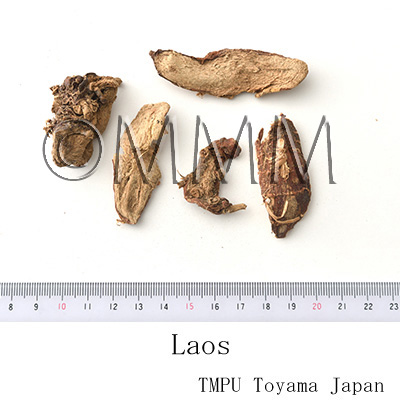Crude drug sample data base
※Click on the image to enlarge it.
The capital city, provincial capital city or the representative
location of its administrative area is indicated.
location of its administrative area is indicated.
-7.0051453
110.43812539999999
Production area information
Republic of Indonesia,Central Java Province
https://ethmed.toyama-wakan.net/img/pin_san.png
-7.2574719
112.75208829999997
Collection information
Republic of Indonesia,East Java Province
https://ethmed.toyama-wakan.net/img/pin_nyu.png
Scientific information data base
| Crude drug name | Indonesian name, English name | Laos, Greater galangal | ||||
|---|---|---|---|---|---|---|
| Synonyms | Lengkua | |||||
| crude drug image |
| |||||
| Original plant name | Alpinia galanga Willd. | |||||
| Family name | Zingiberaceae | |||||
| Used part | Rhizome | |||||
| Distribution area | It is cultivated in all South-East Asian countries and in India, Bangladesh, China, Surinam [204]. It occurs in Java in old clearings, thickets, forests and also cultivated [201, 204]. | |||||
| Description | The plant is a robust, tillering, perennial herb up to 3.5 m tall, with subterranean, creeping, copiously branched, rhizome.There are 2 cultivars: red cultivar and white cultivar. Rhizome subterete, 2-4 cm in diameter, hard, fibrous, shiny, light red (in red cultivar)or pale yellow (in white cultivar), fragrant. Pseudostem erect. Leaves alternate, sheath densely pubescent at apex, ligule truncate, densely pubescent; blade oblong-lanceolate, base cuneate, glossy green. Inflorescence terminal, erect, many flowered, racemose, pubescent, flower fragrant. Fruit a globose to ellipsoidal capsule, orange-red to wine red. Odour: aromatic, taste: pungent [204]. | |||||
| Drug effect | Hot, warming, blood cleanser [231]. | |||||
| Specific actions | Stomachic, diaphoretic, carminative, aromatic, stimulant, expectorant, antifungi [231]. | |||||
| Frequency in use | Abundant | |||||
| Common uses | Rhizomes of white cultivar are commonly used in everyday cooking as a spice. The flowers and young shoots are used as a vegetable. It is an appetite stimulant [201, 204]. | |||||
| Pharmacological effect | Study on its biological activities revealed antibacterial, antifungal, antiprotozoal and expectorant activities [204]. In normal rabbits, powdered rhizome and its methanol and aqueous extracts significantly lowered the blood glucose [PMID:12490221]. From a study on the antiallergic properties of Alpinia galanga rhizomes, it is indicated that the 80% aqueous acetone extract of the rhizomes inhibited release of beta-hexosaminidase, as a marker of antigen-IgE-mediated degranulation in RBL-2H3 cells. Nine known phenylpropanoids and p-hydroxybenzaldehyde were isolated from the extract [PMID:12951092]. 1'S-1'-acetoxychavicol acetate and 1'S-1'-acetoxyeugenol acetate isolated from Alpinia galanga rhizome inhibited the ethanol-induced gastric mucosal lesions. It is suggested that endogenous prostaglandins and sulfhydryl compounds are involved in the protective effect of 1'S-1'-acetoxychavicol acetate [PMID:12809953]. A study showed that 1'S-1'-acetoxychavicol acetate, a small molecular compound isolated from the rhizomes of Alpinia galanga, inhibited Rev transport at a low concentration by binding to chromosomal region maintenance 1 and accumulating full-length HIV-1 RNA in the nucleus, resulting in a block in HIV-1 replication in peripheral blood mononuclear cells. Additionally, acetoxychavicol acetate and didanosine acted synergistically to inhibit HIV-1 replication. Thus, acetoxychavicol acetate may represent a novel treatment for HIV-1 infection, especially in combination with other anti-HIV drugs [PMID:16760408]. | |||||
| Medical system | Indonesian medicine (Jamu) | |||||
| Traditional usage | The rhizome of red cultivar is used for medicinal purposes.Treatment of skin diseases, indigestion, colic, dysentery, enlarged spleen, respiratory diseases, systemic infections, cholera, expectorant, after childbirth. Also as aphrodisiac. A combination of rhizome from red cultivar and rice water and salt is used to treat thin cows, externally it is used to treat boils and wounds [201, 204]. | |||||
| Formulation | Formulae: 1) Blood discharge after childbirth: Red cultivar of galanga cooked with diluted vinegar is a good remedy after childbirth to help discharging the blood. 2) Ringworms: Mixed with garlic, crushed to make a porridge-like mixture. Cook and add a little amount of vinegar, apply in the affected areas. 3) After childbirth poultice: Prepare a mixture of powdered red rice, red galangal, Litsea odorifera leaves, Usnea misaminensis (Usnea sp.) thallus, Zingiber aromaticum rhizome. | |||||
| References | Reference book Tips! | [201] K. Heyne, Tumbuhan Berguna Indonesia, Vols. 1-4, 1987. Diedarkan Oleh Koperasi Karyawan Departemen Kehutanan, Jakarta, Indonesia. Vol. 1, pp 575-577. [204] de Guzman, C.C. and Siemonsma, J.S. (Editors), 1999. Plant Resources of South-East Asia No. 13 Species. Backhuys Publishers, Leiden, Netherlands. pp 65-68. [207] Badan Penelitian Dan Pengembangan Kesehatan and Departemen Kesehatan, Kesejahteraan Sosial Ri. Vols. 1-5, Inventaris Tanaman Obat Indonesia, Jakarta, Indonesia. Vol. 1, Part 2 (2001), pp11-12. [231] Soedibyo, Mooryati: Alam Sumber Kesehatan: Manfaat dan Kegunaan (Natural resources for health. Benefits and uses). Balai Pustaka. 1998. pp 240- 241. | ||||
| Research paper | 1. Ye Y, Li B. 1'S-1'-acetoxychavicol acetate isolated from Alpinia galanga inhibits human immunodeficiency virus type 1 replication by blocking Rev transport. J. Gen. Virol., 87(Pt 7):2047-53, 2006. (PMID: 16760408) 2. Takahashi M, Fuchino H, Satake M, Agatsuma Y, Sekita S. In vitro screening of leishmanicidal activity in myanmar timber extracts. Biol. Pharm. Bull., 27(6):921-5, 2004. (PMID: 15187448) 3. Matsuda H, Morikawa T, Managi H, Yoshikawa M. Antiallergic principles from Alpinia galanga: structural requirements of phenylpropanoids for inhibition of degranulation and release of TNF-alpha and IL-4 in RBL-2H3 cells. Bioorg. Med. Chem. Lett., 13(19):3197-202, 2003. (PMID: 12951092) 4. Matsuda H, Pongpiriyadacha Y, Morikawa T, Ochi M, Yoshikawa M.Gastroprotective effects of phenylpropanoids from the rhizomes of Alpinia galanga in rats: structural requirements and mode of action. Eur. J. Pharmacol., 13;471(1):59-67, 2003. (PMID: 12809953) 5. Someya Y, Kobayashi A, Kubota K. Isolation and identification of trans-2- and trans-3-hydroxy-1,8-cineole glucosides from Alpinia galanga. Biosci. Biotechnol. Biochem., 65(4):950-3, 2001. (PMID: 11388479) | |||||
| Remarks | [DNA sequences]: GU097440, GU097443 It is said that Galanga will remain an important spice for the local market in South-East Asia [204]. | |||||
| Last renewal date | 2024/03/11 | |||||







